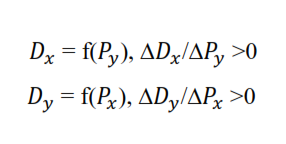Determinants of Demand
There are various factors on which the market demand and individual demand for a product depends. These factors are known as determinants of demand. The knowledge of the determinants of market demand for a product and the nature of relationship between the demand and its determinants proves very helpful in analyzing and estimating demand for the product. These factors can be summarized as follows:
-
Price of the product
The price of a product is one of the most important determinants of its demand in the long run and the only determinant in the short run. The quantity of the product demanded by the consumer inversely depends upon the price of the product. If the price rise demand falls and vice versa. The relation between price and demand is called Law of demand. It is not only the existing price but also the expected changes in price which affect demand.
-
Price of Related goods
The demand for a commodity is also affected by the changes in the price of its related goods. Related goods may be substitutes or complementary goods.
(a) Substitutes
Two commodities are substitutes for one another if change in the price of one affects the demand for the other in the same direction. For example X and Y are substitutes for one another. If price for X increases, demand for Y increases and vice versa. Tea and coffee, hamburgers and hot dogs, Coke and Pepsi are some examples of substitutes in the case of consumer goods.
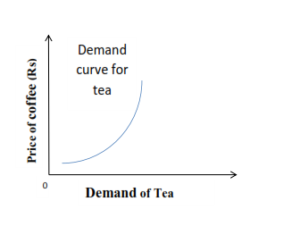
Assuming goods X and Y to be substitutes for one another, the demand function for X and Y with respect to the price of their substitutes can be written as follows:
(b) Complements
Complementary goods are those goods which complete the demand for each other, such as car and petrol or pen and ink. There is an inverse or negative relationship between the demand for first good and price of the second which happens to be complementary to the first. For example an increase in the price of petrol causes a decrease in the demand of car and other petrol run vehicles, other things remaining same. The demand function for car (Dc) in relation to petrol (Pp) can be written as:
The relationship between the demand for a product (car) and the price of its complement (petrol) is shown in the figure below:
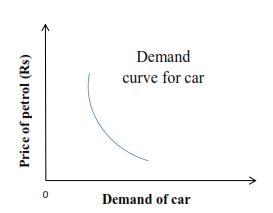
3. Income of the Consumer
Income is the basic determinant of quantity of product demanded since it determines the purchasing power of the consumer. Income as determinant of demand is equally important in both short run and long run. The relationship between the demand for a commodity say, X and the household income Y, assuming all other factors to remain constant, is expressed by a demand function such as :
Experience shows that numerically there is a positive relationship between income of the consumer and his demand for a good. In other words, an increase in income would cause an increase in demand and economists therefore call such goods as normal goods. Normal goods are goods for which an increase in consumer’s income results in an increase in demand. There are some goods, however which are called inferior goods. Inferior good is a good for which an increase in consumer’s income results in a decrease in its demand.
Thus, relationship between income of the consumer and demand for a commodity is discussed with reference to :
a) Essential consumer goods
b) Inferior goods
c) Normal goods
d) Prestige or luxury good
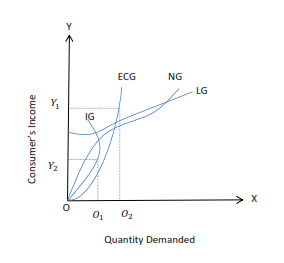
a) Essential consumer goods (ECG)
Essential consumer goods are those which serves the basic needs and are consumed by all persons of a society e.g. food grains, vegetable oils, cooking fuel, salt, minimum clothing, housing etc. Quantity demanded of this category of goods increases with increase in consumer’s income but only upto a certain limit, even though the total expenditure may increase in accordance with the quality of goods consumed, other factors remaining same. The relationship between goods of this category and consumer’s income is shown by the ECG curve in the below figure. As shown in the figure consumer’s demand for essential goods increases only until his income rises to It tends to saturate beyond this level of income.
b) Inferior goods (IG)
Inferior goods are those goods, the demand for which tends to decline with increase in consumer’s income and tends to increase with fall in his income. So there is an inverse relationship between income of the consumer and demand for the commodity. Inferior and superior goods are widely known to both consumers and sellers. For example every consumer knows that kerosene is inferior to cooking gas, travelling by bus is inferior to travelling by taxi. The relation between income and demand for an inferior good is shown by the curve IG in the figure. Demand for such goods rises only upto a certain level of income say and declines as income increases beyond this level.
c) Normal goods (NG)
Normal goods are those goods the demand for which tends to increase with increase in consumer’s income, and tends to decrease with decrease in his income. So there is a positive relationship between consumer’s income and quantity demanded. Clothing, household furniture and automobiles are some of the important examples of this category of goods. The nature of relation between income and demand for the goods of this category is shown by the curve NG. As the curve shows demand for normal goods increases rapidly with the increase in the consumer’s income but slows down with further increases in income.
It may be noted from the figure that upto certain level of income () the relation between income and demand for all types of goods is similar. The difference is only in degree.
d) Luxury and Prestige goods (LG)
All such goods that add to the pleasure and prestige of the consumer without enhancing his earning fall in the category of luxury goods. For example, stone studded jewellery, costly cosmetics, luxury cars, stay in 5 star hotels etc. can be treated as luxury goods. Demand for such goods arises beyond a certain level of consumer’s income.
4. Consumer’s taste and preferences
The demand for any goods and service depends on individual’s taste and preferences. They include fashion, habit, custom etc. Tastes and preferences of the consumers are influenced by advertisement, changes in fashion, climate, new invention. Other things being equal, demand for those goods increases for which consumers develop taste and preferences. Contrary to it, an unfavourable change in consumer preferences and tastes for a product will cause demand to decrease.
5. Advertisement Expenditure
Advertisement costs are incurred with the objective of promoting sale of the product. Advertisements help in increasing the demand in the following ways:
- By informing potential consumers about the product and its availability
- By showing its superiority over rival product
- By influencing consumer’s choice against the rival products
- By setting new fashions and changing tastes.
There are instances when advertisements have changed lifestyle of people. Cadbury India has revolutionized the market for its leading product Dairy Milk through high profile advertising featuring Amitabh Bachchan with a slogan “Kuch mitha ho jai”. The relationship between sale (S) and advertisement outlays (AD) is expressed by the function.
S =f(AD)
The relationship between advertisement outlay and sales is shown in the figure given below:
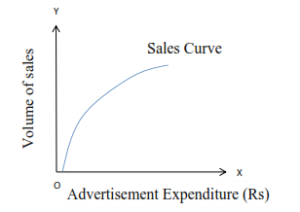
6. Consumer’s Expectations of future Income and Price
Consumers do not make purchases only on the basis of current price structure. Especially in case of durables, when demand can be postponed, consumers decide their purchase on the basis of future price and income. If they expect their income to increase or price to fall in future, they will postpone their demand on the other hand if they expect price to increase in future they will hasten the purchase. For example, purchase of cars and other durables increases before budget is announced if consumers fear that prices may rise after budget. Or, when people expect pay revisions, they wait for major purchases till pay is revised.
7. Population of the Country
Size of population, age distribution, rural urban distribution and gender distribution affect aggregate demand. If population of a country is constantly increasing, more food items and other goods and services will be needed to satisfy the needs of the people. Age distribution of the population determines what kind of commodities will be demanded. If population mostly consists of aged people, there will be demand of more medicines and health care services. On the other hand if major section of population is youth, there will be more demand for education , employment opportunities and designer apparels.
8. Demonstration Effect
When new commodities or new models of existing one appear in the market rich people buy then first. For example if new model of a car appears in the market, rich people would mostly be the first buyers. Some people buy new models of goods because they have genuine need for them or have excess purchasing power. Some others do so because they want to exhibit their affluence. But once new commodities are in vogue, many households buy then bot because they have a genuine need for them but because their neighbors have bought these goods. The purchase made by the latter category of the buyers arise out of such feelings as jealousy, competition and equality in peer group, social inferiority and the desire to raise their social status. Purchases made on account of these factors are the result of what economists call “demonstration effect” or the “ band- wagon effect”. These effects have positive effect on demand. On the other hand, when commodity becomes the thing of common use, some people mostly rich, decrease or give up the consumption of such goods. This is known as the “ Sob Effect”. It has a negative effect on the demand for the related goods.
9. Credit Facility
Availability of credit to the consumers from the sellers, banks, relations and friends, or from other source encourages the consumers to buy more than what they would buy in absence of credit availability. That is why consumers who can borrow more can consume more than those who cannot borrow. Credit facility mostly affects the demand for durable goods, particularly those which require bulk payment at the time of purchase. The managers who are assessing the prospective demand for their products should, therefore take into account the availability of credit to the consumers.
10. Distribution of National Income
The level of national income is the basic determinant of the market demand for a product. The higher the national income, the higher the demand for all normal goods and services. Apart from its level, the distribution pattern of national income is also an important determinant of a product. If national income is unevenly distributed i.e. majority of the population belongs to lower income groups, market demand for essential goods including inferior ones, will be the largest whereas the demand for other kinds of goods will be relatively lower.
11. Growth of Economy
Economy’s growth rate determines the general mood of business and general standard of living. If an economy is growing, it will have increased demands for goods of better quality. Consumers will have higher paying capacity and greater willingness to pay higher for quality. Thus producers will be under pressure to produce good quality products and add variety to their existing products.
12. Government Policy
Government policy affects the demand for commodities through taxation. Taxing a commodity increases its price and the demand goes down. Similarly, financial help from the government increases the demand for a commodity while lowering its price.
13. Climate and weather of area
The climate of an area and the weather prevailing there have a decisive effect on consumer’s demand. In cold areas woolen cloth is demanded. During hot summer days, ice is very much in demand. On a rainy day, ice cream is not much demanded.
14. Business conditions
The level of demand for different commodities also depends upon the business conditions in the country. If the country is passing through boom conditions, there will be a marked increase in demand. On the other hand, the level of demand goes down during depression.
For more notes on Managerial Economics click on the link below:
Search items used for this information
• Determinants of demand • Determinants of demand in economics • Determinants of demand meaning • Determinants of demand with diagram • Determinants of demand in equation • Key determinants of demand • Determinants of demand managerial economics

